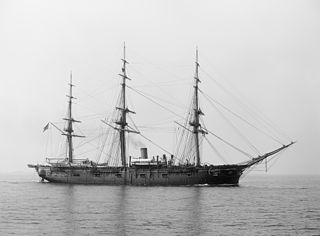
USS Dolphin (PG-24) was a gunboat/dispatch vessel; the fourth ship of the United States Navy to share the name. Dolphin was the first U.S. Navy ship to fly the flag of the president of the United States during President Chester A. Arthur's administration, and the second Navy ship to serve as a presidential yacht.

The first USS Philip (DD–76) was a Wickes-class destroyer in the United States Navy during World War I, later transferred to the Royal Navy as HMS Lancaster. She was named for John Woodward Philip.

USS Helena (PG-9) was a Wilmington-class gunboat of the United States Navy. She participated in the Spanish–American War, and served in the Far East for many years. The (PG-9) was the first of five Navy vessels named after the capital city of Montana.

The first USS Haraden (DD–183) was a Wickes-class destroyer in the United States Navy in the period following World War I. She was later transferred to the Royal Canadian Navy as HMCS Columbia, as a Town-class destroyer.

The fourth USS Columbia (C-12/CA-16) was a protected cruiser in the United States Navy during the Spanish–American War and World War I. She was the lead ship of her class of two cruisers; her sister ship was Minneapolis (C-13). The class was originally designed with three funnels; however, Columbia was built with four and Minneapolis with two. This may have been to make them resemble specific passenger liners.

The first USS Lancaster was a screw sloop-of-war in the United States Navy during the American Civil War through the Spanish–American War.

USS Solace (AH-2) was a hospital ship in the United States Navy. Solace was built in 1896 and 1897 by the Newport News Shipbuilding & Drydock Co., Newport News, Virginia, and was operated as the SS Creole by the Cromwell Steamship Lines. The ship was acquired by the United States Navy on 7 April 1898, renamed Solace, and converted into a hospital ship. She was the first Navy ship to fly the Geneva Red Cross flag. Solace was commissioned on 14 April 1898.

USS Nashville (PG-7), a gunboat, was the only ship of its class. It was the first of three ships of the United States Navy to hold the name Nashville.

The third USS Princeton was a composite gunboat in the United States Navy.

USS Ranger, later USS Rockport and USS Nantucket (PG-23/IX-18), was a gunboat of the United States Navy. A screw steamer with full-rig auxiliary sail, Ranger was destined for a very long 65-year career, serving first as a U.S. Navy gunboat from 1876 to 1920, and later as a training ship with the Massachusetts Maritime Academy from 1909 to 1941.
USS Newport (PF-27), a Tacoma-class frigate in commission from 1944 to 1945, and from 1950 to 1952, was the second ship of the United States Navy to be named for the city of Newport, Rhode Island. She later served in the Soviet Navy as EK-28 and in the Japan Maritime Self-Defense Force as JDS Kaede (PF-13), JDS Kaede (PF-293) and as YAC-17.

USS Cincinnati (C-7) was a protected cruiser and the lead ship of the Cincinnati-class cruiser for the United States Navy. She was launched on 10 November 1892 by New York Navy Yard; sponsored by Miss S. Mosby; and commissioned on 16 June 1894. She was the second ship to be named after Cincinnati, Ohio.

USS Porter was a torpedo boat, the first of her class, launched in 1896, served during the Spanish–American War, and struck in 1912. She was the first Navy ship named for Commodore David Porter, and his son, Admiral David Dixon Porter.

USS Wheeling (PG-14) was a Wheeling-class gunboat acquired by the United States Navy in 1897. She served as a gunboat during the Spanish–American War as well as a convoy escort during World War I. As IX-28 she also served as a schoolship for the training of Naval Reservists, and, at the end of World War II, just before being struck from the Navy records, she was temporarily assigned as a barracks ship for torpedo boat crews.

The first USS Machias (PG-5), a schooner-rigged gunboat, was laid down in February 1891 by Bath Iron Works, Bath, Maine. She was launched on 8 December 1891. She was sponsored by Miss Ethel Hyde, daughter of President Hyde of Bath Iron Works and commissioned at Portsmouth Navy Yard, Kittery, Maine, 20 July 1893, Commander Charles J. Train in command.
The first USS McKee was laid down on 11 September 1897 by Columbian Iron Works, Baltimore, Maryland, United States, launched 5 March 1898; sponsored by Mrs. William H. Humrichouse; and commissioned 16 May 1898.

The third USS Somers, a steel torpedo boat built as a private speculation by Friedrich Schichau, Elbing, Germany, was launched in 1897 as yard No. 450; purchased for the United States Navy on 25 March 1898; commissioned on 28 March 1898 and named Somers the next day.

USS Fulton (AS-1) was constructed as a submarine tender in 1914, but later was converted into a gunboat and redesignated PG-49.

USS Topeka (PG-35) was a gunboat of the United States Navy.

The Peoria, a converted steel gunboat, was built as the pilot boat Philadelphia by Neafie and Levy ship and engine building company in Philadelphia, Pennsylvania in March 1896 for the Pennsylvania and Delaware Pilots' Association. The Philadelphia was purchased by the US Navy on 23 May 1898 from the Philadelphia Pilots' Association, and was renamed Peoria. She was commissioned on 15 May 1898.


















